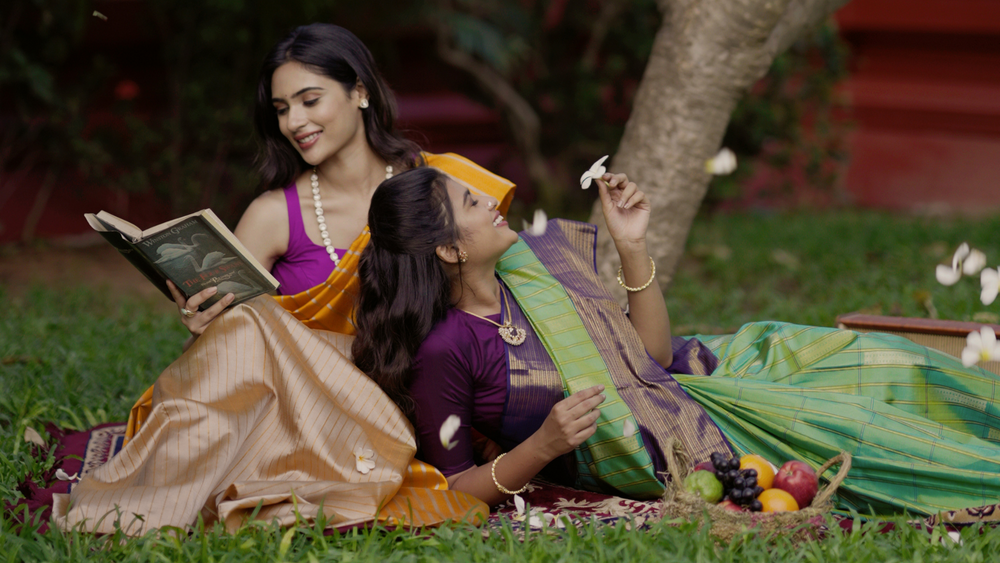Kanjivaram Patterns and Motifs
Kanjivaram sarees are known for their intricate designs and beautiful motifs, which are inspired by the architecture of a thousand temples and the natural environment of Kanchipuram. Among these motifs, floral patterns are some of the most popular and widely recognized. At Pashudh, we offer a range of stunning Kanjivaram sarees featuring intricate floral motifs, patterns that are sure to take your breath away.
Thuthiripoo (Udhiripoo) Motif:
The Thuthiripoo, also known as Udhiripoo, is a small white flower that is commonly found in Southern India. This delicate flower is often used in traditional Indian flower arrangements and is considered to be a symbol of purity and grace. The Thuthiripoo motif is often woven in shades of white and gold, and features intricate designs that mimic the shape and texture of the flower.
 Kamalam or Thamarai (Lotus) Motif:
Kamalam or Thamarai (Lotus) Motif:
The Kamalam or Thamarai, also known as the lotus flower, is a popular floral pattern in Kanjivaram sarees. This flower is considered to be a symbol of purity and enlightenment in Hinduism and Buddhism, and is often associated with the goddess of wealth and prosperity, Lakshmi. The Kamalam or Thamarai motif is often woven in shades of pink and gold, and features intricate designs that mimic the shape and texture of the flower.
Kodi Visiri (Creeper) Motif:
The Kodi Visiri, also known as the creeper, is a popular floral pattern in Kanjivaram sarees that is inspired by the vines and creepers that grow throughout the region. This motif is often woven in shades of green and gold, and features intricate designs that mimic the shape and texture of the vines and leaves.

Malli Moggou (Jasmine Bud) Motif:
The Malli Moggou, also known as the jasmine bud, is a popular floral motif in Kanjivaram sarees that is inspired by the fragrant jasmine flower. The jasmine flower is often used in traditional Indian flower arrangements and is considered to be a symbol of purity and simplicity. The Malli Moggou motif is often woven in shades of white and gold, and features intricate designs that mimic the shape and texture of the bud.
In addition to floral motifs, there are several other popular patterns that are commonly found in Kanjivaram sarees, such the manga, gopuram, rudraksham, and kamalam.
Manga Motif:
The manga motif is inspired by the mango fruit and is one of the most recognized patterns in Kanjivaram sarees. The mango is considered to be a symbol of love, fertility, and prosperity in Indian culture, and the manga motif is often woven in shades of green and gold, with intricate designs that mimic the shape and texture of the fruit.
Gopuram Motif:
The gopuram motif is inspired by the towering entrance gates of South Indian temples, which are often adorned with intricate carvings and designs. The gopuram motif is often woven in shades of red and gold, with designs that mimic the intricate patterns and carvings found on temple entrances.
 Rudraksham Motif:
Rudraksham Motif:
The rudraksham motif is inspired by the sacred rudraksha beads, which are often used in traditional Hindu prayers and rituals. The beads are believed to have spiritual and healing properties, and they are considered to be a symbol of Lord Shiva, one of the principal deities of Hinduism. The rudraksham motif is typically woven in shades of brown and gold, and it features intricate designs that mimic the texture and pattern of the beads.
Kamalam (Thamarai) Motif:
The kamalam or thamarai motif, as mentioned earlier, is inspired by the lotus flower, which is considered to be a symbol of purity and enlightenment in Hinduism and Buddhism. The lotus flower is often associated with the goddess of wealth and prosperity, Lakshmi, and it is widely used in traditional Indian art and architecture. The kamalam or thamarai motif is typically woven in shades of pink and gold, and it features intricate designs that mimic the shape and texture of the flower
Among these motifs, the seep rekku, kattam vari, paai maadi, and thazhampoo reku patterns are some of the lesser-known but equally stunning designs.
Seep Rekku:
The Seep Rekku pattern is inspired by the roots of the banyan tree, which are often seen creeping along the ground and growing on other trees. The banyan tree is considered to be sacred in Hinduism, and it is often associated with Lord Shiva. The Seep Rekku pattern is typically woven in shades of green and gold, and it features intricate designs that mimic the twisting and turning of the banyan tree roots.
Kattam Vari:
The kattam vari pattern is inspired by the intricate designs of the traditional South Indian floor tiles. These tiles are known for their geometric patterns and bold colors, and they are often found in the homes and temples of the region. The kattam vari motif is woven with bright shades of green, pink, and gold, and it features intricate designs that mimic the beautiful patterns of the tiles.
Thazhampoo Reku:
The thazhampoo reku is inspired by the fragrant and delicate thazhampoo flower, which is commonly found in South India. The flower is often used in traditional Indian haircare and is believed to have a cooling effect on the scalp. The thazhampoo reku is typically woven in shades of pink and gold, and it features intricate designs that mimic the shape and texture of the flower.
Paai Maadi:
The Paai Maadi pattern is inspired by the traditional woven mats that are used in South India. These mats are typically woven from coconut leaves or grass, and they are used for seating or as floor coverings. The Paai Maadi pattern is typically woven in shades of green and gold, and it features intricate designs that mimic the texture and pattern of the woven mats.
In conclusion, the Kanjivaram saree is a timeless masterpiece that embodies the rich cultural heritage of South India. These sarees are steeped in tradition and are a reflection of the artistic and weaving skills of generations of skilled artisans. At Pashudh, we take great pride in offering a range of Kanjivaram sarees that honor these traditions and pay homage to the rich cultural heritage of South India. Each saree is a unique work of art, crafted with the utmost care and attention to detail. We hope that our collection of Kanjivaram sarees inspires you to appreciate the beauty and significance of these traditional sarees and encourages you to add them to your wardrobe as a testament to the rich cultural history of South India.






Leave a comment